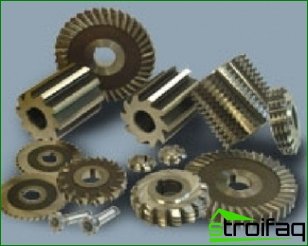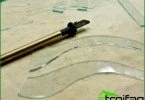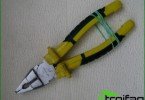Woodworking milling cutters are used to make edges, grooves, rebates and more. Thanks to them, profiles and grooves are made on wooden products. The milling method allows you to process almost any flat and shaped surface. A milling cutter is a device that rotates a tool at high speed around its axis and makes it perform translational movements, which can be screw, rectilinear or rotational.
To perform this processing, special tools are used – milling machines. The milling machine or milling machine is equipped with an electric motor, which is located on a stable base. It can be based on a table that connects to the engine with a pin. Installation involves the presence of a horizontal washer, which is necessary to determine the depth of processing. Let’s look at the features of choosing a mill for woodworking.
Varieties of woodworking milling cutters
There are various types of mills: cylindrical, face, shaped, angled, disk, end and key. Each type has its own characteristics, which play an important role in choosing this tool. Let’s take a closer look at them. On machines of horizontal shape, cylindrical cutters are used. The surface processed with their help should be flat. The teeth on these machines can be straight and helical..
Straight teeth allow you to process planes of small width, and for helical, wide surfaces are suitable. When using these devices, axial forces will arise, which will depend on the axis of inclination of the tooth. Avoid such inconveniences allow special milling cutters, have two rows of teeth located in different directions. The performance of face mills is an order of magnitude higher than cylindrical counterparts.
They are used on vertical milling machines, and the upper parts of the edges of the teeth are profiled. At the ends are auxiliary cutting edges. And the main function is performed by the outer side edges. Angle cutters find their application in those cases when it is necessary to make grooves on the corners and to form grooves for the angular profile. Such cutters can be two-angle and single-angle. Single-angle models have edges located on the conical surface and ends. In two-angle milling cutters, the edges are adjacent on two surfaces. This arrangement allows for smooth operation, since it compensates for the axial forces arising. To reduce wear, the tops of the corner cutters are made rounded.
Classification of mills
Milling cutters can differ in the shape of the back surface of the edges. Edges can be curved or straight. To work with profiles in the backed mills, spiral-shaped knives are used. Pointed milling cutters are used if it is necessary to manufacture tongue-and-groove joints. They are made in the form of a cylinder on which there are cutting edges..
Cutters are divided into types according to the method of the device on the spindle. According to this characteristic, the tool is end and mounted. End mills have another name – tail. They are fixed with a collet and chuck. And milling cutters should be screwed into the spindle. The cutters are screwed in the direction opposite to the direction of movement. In addition, cutters are draft and finish. Drafts are used for quick rough processing, and thanks to finishing mills you can get a smooth surface.
Choose a cutter
Woodworking milling cutters are used to make edges, grooves, rebates and more. Thanks to them, profiles and grooves are made on wooden products. The milling method allows you to process almost any flat and shaped surface. A milling cutter is a device that rotates a tool at high speed around its axis and makes it perform translational movements, which can be screw, rectilinear or rotational.
To perform this processing, special tools are used – milling machines. The milling machine or milling machine is equipped with an electric motor, which is located on a stable base. It can be based on a table that connects to the engine with a pin. Installation involves the presence of a horizontal washer, which is necessary to determine the depth of processing. Let’s look at the features of choosing a mill for woodworking.
Varieties of woodworking milling cutters
There are various types of mills: cylindrical, face, shaped, angled, disk, end and key. Each type has its own characteristics, which play an important role in choosing this tool. Let’s take a closer look at them. On machines of horizontal shape, cylindrical cutters are used. The surface processed with their help should be flat. The teeth on these machines can be straight and helical..
Straight teeth allow you to process planes of small width, and for helical, wide surfaces are suitable. When using these devices, axial forces will arise, which will depend on the axis of inclination of the tooth. Avoid such inconveniences allow special milling cutters, have two rows of teeth located in different directions. The performance of face mills is an order of magnitude higher than cylindrical counterparts.
They are used on vertical milling machines, and the upper parts of the edges of the teeth are profiled. At the ends are auxiliary cutting edges. And the main function is performed by the outer side edges. Angle cutters find their application in those cases when it is necessary to make grooves on the corners and to form grooves for the angular profile. Such cutters can be two-angle and single-angle. Single-angle models have edges located on the conical surface and ends. In two-angle milling cutters, the edges are adjacent on two surfaces. This arrangement allows for smooth operation, since it compensates for the axial forces arising. To reduce wear, the tops of the corner cutters are made rounded.
Classification of mills
Milling cutters can differ in the shape of the back surface of the edges. Edges can be curved or straight. To work with profiles in the backed mills, spiral-shaped knives are used. Pointed milling cutters are used if it is necessary to manufacture tongue-and-groove joints. They are made in the form of a cylinder on which there are cutting edges..
Cutters are divided into types according to the method of the device on the spindle. According to this characteristic, the tool is end and mounted. End mills have another name – tail. They are fixed with a collet and chuck. And milling cutters should be screwed into the spindle. The cutters are screwed in the direction opposite to the direction of movement. In addition, cutters are draft and finish. Drafts are used for quick rough processing, and thanks to finishing mills you can get a smooth surface.
Choose a cutter
To select the cutter, the characteristics of the machine should be taken into account. Each machine has a passport, which indicates the range of mounted mills that can be installed on it. These characteristics determine the diameter of a suitable milling cutter. Most often it is in the range from 80 to 180 millimeters. Another important indicator is the method of mounting on the spindle. Cutters with an increased diameter of the mounting holes are installed using special bushings and chucks.
If the mandrel of the machine does not have a thread for nuts, then this model needs special hydraulic bushings. In addition, cutters that are used in fastening nuts and collets can also be used. When choosing a cutter, you should pay attention to the alloy of the teeth. The strength of the processed material will largely depend on its strength. In addition, the milling cutter can be checked for manufacturing accuracy..
Remember that some manufacturers make low-quality cutters. So, we examined the main features of the choice of cutters for woodworking. After reviewing them, you can mellowly go to the store for these components.







